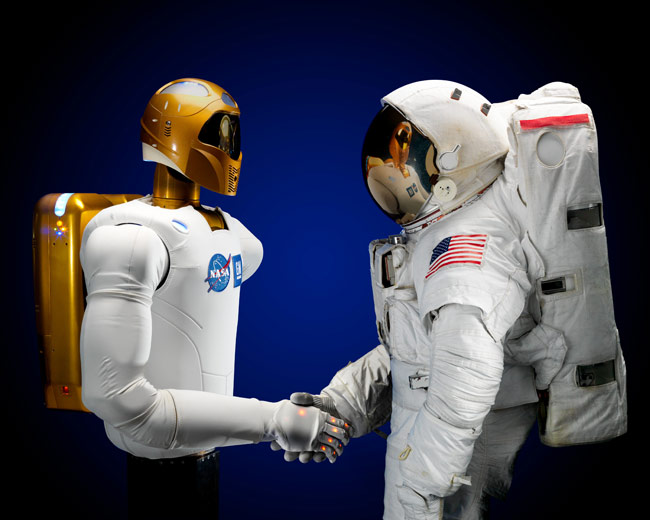Robot Butler for Astronauts Is a Hit on Twitter

The first humanoid robot headed for space is taking Twitter by storm by posting updates on its coming spaceflight, and it was prepared to meet the press Wednesday.
NASA robot handlers have been posting messages for the new space automaton, called Robonaut 2, under the name @AstroRobonaut since late last month and had gained more than 7,600 followers as of Wednesday morning.
The robot, which is due aboard the International Space Station in November, is meant to help astronauts with mundane chores and to venture into situations that are too risky for flesh-and-blood explorers.
On Wednesday Robonaut 2 "answered" questions via Twitter from NASA's Johnson Space Center in Houston hours before a scheduled appearance for local reporters.
Among the top questions for the robot butler: Exactly what does it plan on doing in space?
"I'm going to go through lots of tests, first," read one of Robonaut 2's Twitter responses. "Then we'll see — I'm up for anything too dangerous or dull for astronauts."
To be clear, Robonaut 2 is currently operated by preprogrammed commands, and not completely reliant on its own artificial intelligence. It is built to use mechanical arms and hands to operate the same tools used by station astronauts. [5 Reasons to Fear Robots]
Breaking space news, the latest updates on rocket launches, skywatching events and more!
Still, Robonaut 2 has a lot to live up to, so to speak. NASA engineers want to know how the robot will perform in microgravity and whether it can be a suitable astronaut assistant on space missions.
If its Twitter activity is any sign, the expectations of a generation of space fans that grew up with the robots of science fiction are also along for the ride. One fan invited Robonaut 2 to Venezuela for a visit.
"I'm going to be tied up with going to space for ... the rest of my life. But thanks for the invite!" came the response.
The astronaut-helper has no voice, only a Twitter account.
Robonaut 2 also has no legs. It consists of an upper torso, arms, hands and a sensor-packed head. In all, it weighs about 300 pounds (136 kg). It will launch to the space station on NASA's shuttle Discovery in November.
Robonaut 2 takes on Twitter
Twitter users have already peppered Robonaut 2 with wave after wave of questions, ranging from how the droid works to its mechanical lineage.
"No, no relation to Hal," read a July 30 Robonaut 2 post in response to a follower asking if it was connected to the infamous computer in the film "2001: A Space Odyssey." "Don't know if I'd want to admit to having him on my family tree if I was. [Definitely] don't condone his actions."
The fictional HAL 9000 computer killed most of its ship's crew in the 1968 Stanley Kubrick film co-written by Arthur C. Clarke.
Another follower asked if Robonaut 2 was related to the "Star Wars" bounty hunter Boba Fett. After all, its predecessor — the original Robonaut — had a head that resembled Fett's trademark helmet.
"Sorry, no relation to Boba Fett," Robonaut 2's handlers replied, meeting the same diplomatic challenge. "Besides, I'm a friendly robot."
The barrage of questions started as soon as NASA launched Robonaut 2's Twitter account July 26.
"Hello World! My name is Robonaut 2 — R2 for short," the robot's handlers announced that day. "Follow my adventures here as I prepare for space!"
So far, the questions also have included inquires about Robonaut 2's gender (it has none), language skills (only computer code and English), whether it plays chess (yes, but only with human assistance) and if it has a dog (complicated to explain).
Next stop: space
After months of testing, Robonaut 2 is nearing its final rounds of upgrades before it flies to the International Space Station Nov. 1.
Designed to resemble and mimic humans in a variety of tasks, the humanoid robot was created by NASA and General Motors and first conceived for use on Earth. But engineers wanted to see how it would fare in the environment of space.
"You want to make sure things behave the way things expect them to," press officer Brandi Dean at the Johnson Space Center in Houston told SPACE.com. "We've never put a dexterous humanoid robot in space before. So we can make theories about how they'll behave in space, but it's always great to check them."
NASA officials have said Robonaut 2 is the most advanced dexterous humanoid robot in existence. It will be the first humanoid robot to reach orbit and the first American-built robot at the space station, they say.
The space station already has a maintenance robot, called Dextre, which is mounted to the exterior of the orbiting laboratory and designed to make routine repairs and equipment replacements. Unlike Robonaut 2, Dextre is not humanoid and stays outside the space station.
Still, some of Robonaut 2's followers sense a trend.
"The robots, they're taking over space!" one Twitter user going by the moniker @phillipstobbart wrote in a recent post.
"Nah. We're not taking over — I'm here to help!" Robonaut 2's handlers replied.
Zoe Macintosh is a science writer who covered human spaceflight, astronomy and science for Space.com in 2010. She also covered general science for Space.com's sister site Live Science. Zoe studied English literature and physics at Smith College, where she also wrote for the Smith Sophian. Her work has also appeared in the National Association of Science Writers website.
